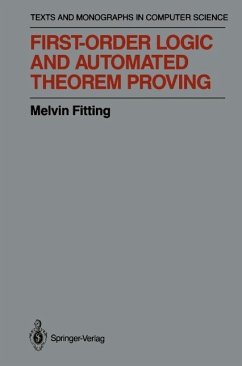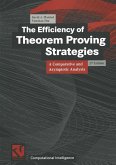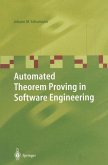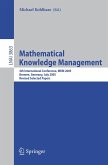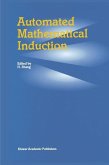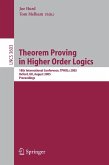Melvin Fitting
First-Order Logic and Automated Theorem Proving (eBook, PDF)
62,95 €
62,95 €
inkl. MwSt.
Sofort per Download lieferbar

31 °P sammeln
62,95 €
Als Download kaufen

62,95 €
inkl. MwSt.
Sofort per Download lieferbar

31 °P sammeln
Jetzt verschenken
Alle Infos zum eBook verschenken
62,95 €
inkl. MwSt.
Sofort per Download lieferbar
Alle Infos zum eBook verschenken

31 °P sammeln
Melvin Fitting
First-Order Logic and Automated Theorem Proving (eBook, PDF)
- Format: PDF
- Merkliste
- Auf die Merkliste
- Bewerten Bewerten
- Teilen
- Produkt teilen
- Produkterinnerung
- Produkterinnerung

Bitte loggen Sie sich zunächst in Ihr Kundenkonto ein oder registrieren Sie sich bei
bücher.de, um das eBook-Abo tolino select nutzen zu können.
Hier können Sie sich einloggen
Hier können Sie sich einloggen
Sie sind bereits eingeloggt. Klicken Sie auf 2. tolino select Abo, um fortzufahren.

Bitte loggen Sie sich zunächst in Ihr Kundenkonto ein oder registrieren Sie sich bei bücher.de, um das eBook-Abo tolino select nutzen zu können.
A rigorous mathematical monograph on classical first-order logic. Applications to automated theorem-proving are considered and Prolog programs provided. May serve as a first text on formal logic for graduate students of computer science or mathematics.
- Geräte: PC
- ohne Kopierschutz
- eBook Hilfe
- Größe: 24.7MB
Andere Kunden interessierten sich auch für
![The Efficiency of Theorem Proving Strategies (eBook, PDF) The Efficiency of Theorem Proving Strategies (eBook, PDF)]() David A. PlaistedThe Efficiency of Theorem Proving Strategies (eBook, PDF)40,95 €
David A. PlaistedThe Efficiency of Theorem Proving Strategies (eBook, PDF)40,95 €![Automated Theorem Proving (eBook, PDF) Automated Theorem Proving (eBook, PDF)]() Wolfgang BibelAutomated Theorem Proving (eBook, PDF)72,95 €
Wolfgang BibelAutomated Theorem Proving (eBook, PDF)72,95 €![Automated Theorem Proving in Software Engineering (eBook, PDF) Automated Theorem Proving in Software Engineering (eBook, PDF)]() Johann M. SchumannAutomated Theorem Proving in Software Engineering (eBook, PDF)40,95 €
Johann M. SchumannAutomated Theorem Proving in Software Engineering (eBook, PDF)40,95 €![Mathematical Knowledge Management (eBook, PDF) Mathematical Knowledge Management (eBook, PDF)]() Mathematical Knowledge Management (eBook, PDF)40,95 €
Mathematical Knowledge Management (eBook, PDF)40,95 €![Automated Mathematical Induction (eBook, PDF) Automated Mathematical Induction (eBook, PDF)]() Automated Mathematical Induction (eBook, PDF)72,95 €
Automated Mathematical Induction (eBook, PDF)72,95 €![Mechanical Theorem Proving in Geometries (eBook, PDF) Mechanical Theorem Proving in Geometries (eBook, PDF)]() Wen-Tsün WuMechanical Theorem Proving in Geometries (eBook, PDF)40,95 €
Wen-Tsün WuMechanical Theorem Proving in Geometries (eBook, PDF)40,95 €![Theorem Proving in Higher Order Logics (eBook, PDF) Theorem Proving in Higher Order Logics (eBook, PDF)]() Theorem Proving in Higher Order Logics (eBook, PDF)40,95 €
Theorem Proving in Higher Order Logics (eBook, PDF)40,95 €-
-
-
A rigorous mathematical monograph on classical first-order logic. Applications to automated theorem-proving are considered and Prolog programs provided. May serve as a first text on formal logic for graduate students of computer science or mathematics.
Dieser Download kann aus rechtlichen Gründen nur mit Rechnungsadresse in A, B, BG, CY, CZ, D, DK, EW, E, FIN, F, GR, HR, H, IRL, I, LT, L, LR, M, NL, PL, P, R, S, SLO, SK ausgeliefert werden.
Produktdetails
- Produktdetails
- Verlag: Springer US
- Seitenzahl: 242
- Erscheinungstermin: 6. Dezember 2012
- Englisch
- ISBN-13: 9781468403572
- Artikelnr.: 44063487
- Verlag: Springer US
- Seitenzahl: 242
- Erscheinungstermin: 6. Dezember 2012
- Englisch
- ISBN-13: 9781468403572
- Artikelnr.: 44063487
- Herstellerkennzeichnung Die Herstellerinformationen sind derzeit nicht verfügbar.
1 Background.- 2 Propositional Logic.- 2.1 Introduction.- 2.2 Propositional Logic-Syntax.- 2.3 Propositional Logic-Semantics.- 2.4 Boolean Valuations.- 2.5 The Replacement Theorem.- 2.6 Uniform Notation.- 2.7 König's Lemma.- 2.8 Normal Forms.- 2.9 Normal Form Implementations.- 3 Semantic Tableaux and Resolution.- 3.1 Propositional Semantic Tableaux.- 3.2 Propositional Tableaux Implementations.- 3.3 Propositional Resolution.- 3.4 Soundness.- 3.5 Hintikka's Lemma.- 3.6 The Model Existence Theorem.- 3.7 Tableau and Resolution Completeness.- 3.8 Completeness With Restrictions.- 3.9 Propositional Consequence.- 4 Other Propositional Proof Procedures.- 4.1 Hilbert Systems.- 4.2 Natural Deduction.- 4.3 The Sequent Calculus.- 4.4 The Davis-Putnam Procedure.- 4.5 Computational Complexity.- 5 First-Order Logic.- 5.1 First-Order Logic-Syntax.- 5.2 Substitutions.- 5.3 First-Order Semantics.- 5.4 Herbrand Models.- 5.5 First-Order Uniform Notation.- 5.6 Hintikka's Lemma.- 5.7 Parameters.- 5.8 The Model Existence Theorem.- 5.9 Applications.- 5.10 Logical Consequence.- 6 First-Order Proof Procedures.- 6.1 First-Order Semantic Tableaux.- 6.2 First-Order Resolution.- 6.3 Soundness.- 6.4 Completeness.- 6.5 Hilbert Systems.- 6.6 Natural Deduction and Gentzen Sequents.- 7 Implementing Tableaux and Resolution.- 7.1 What Next.- 7.2 Unification.- 7.3 Unification Implemented.- 7.4 Free-Variable Semantic Tableaux.- 7.5 A Tableau Implementation.- 7.6 Free-Variable Resolution.- 7.7 Soundness.- 7.8 Free-Variable Tableau Completeness.- 7.9 Free-Variable Resolution Completeness.- 8 Further First-Order Features.- 8.1 Introduction.- 8.2 The Replacement Theorem.- 8.3 Skolemization.- 8.4 Prenex Form.- 8.5 The AE-Calculus.- 8.6 Herbrand's Theorem.- 8.7 Herbrand's Theorem, Constructively.-8.8 Gentzen's Theorem.- 8.9 Cut Elimination.- 8.10 Do Cuts Shorten Proofs?.- 8.11 Craig's Interpolation Theorem.- 8.12 Craig's Interpolation Theorem-Constructively.- 8.13 Beth's Definability Theorem.- 8.14 Lyndon's Homomorphism Theorem.- 9 Equality.- 9.1 Introduction.- 9.2 Syntax and Semantics.- 9.3 The Equality Axioms.- 9.4 Hintikka's Lemma.- 9.5 The Model Existence Theorem.- 9.6 Consequences.- 9.7 Tableau and Resolution Systems.- 9.8 Alternate Tableau and Resolution Systems.- 9.9 A Free-Variable Tableau System With Equality.- 9.10 A Tableau Implementation With Equality.- 9.11 Paramodulation.- References.
1 Background.- 2 Propositional Logic.- 2.1 Introduction.- 2.2 Propositional Logic-Syntax.- 2.3 Propositional Logic-Semantics.- 2.4 Boolean Valuations.- 2.5 The Replacement Theorem.- 2.6 Uniform Notation.- 2.7 König's Lemma.- 2.8 Normal Forms.- 2.9 Normal Form Implementations.- 3 Semantic Tableaux and Resolution.- 3.1 Propositional Semantic Tableaux.- 3.2 Propositional Tableaux Implementations.- 3.3 Propositional Resolution.- 3.4 Soundness.- 3.5 Hintikka's Lemma.- 3.6 The Model Existence Theorem.- 3.7 Tableau and Resolution Completeness.- 3.8 Completeness With Restrictions.- 3.9 Propositional Consequence.- 4 Other Propositional Proof Procedures.- 4.1 Hilbert Systems.- 4.2 Natural Deduction.- 4.3 The Sequent Calculus.- 4.4 The Davis-Putnam Procedure.- 4.5 Computational Complexity.- 5 First-Order Logic.- 5.1 First-Order Logic-Syntax.- 5.2 Substitutions.- 5.3 First-Order Semantics.- 5.4 Herbrand Models.- 5.5 First-Order Uniform Notation.- 5.6 Hintikka's Lemma.- 5.7 Parameters.- 5.8 The Model Existence Theorem.- 5.9 Applications.- 5.10 Logical Consequence.- 6 First-Order Proof Procedures.- 6.1 First-Order Semantic Tableaux.- 6.2 First-Order Resolution.- 6.3 Soundness.- 6.4 Completeness.- 6.5 Hilbert Systems.- 6.6 Natural Deduction and Gentzen Sequents.- 7 Implementing Tableaux and Resolution.- 7.1 What Next.- 7.2 Unification.- 7.3 Unification Implemented.- 7.4 Free-Variable Semantic Tableaux.- 7.5 A Tableau Implementation.- 7.6 Free-Variable Resolution.- 7.7 Soundness.- 7.8 Free-Variable Tableau Completeness.- 7.9 Free-Variable Resolution Completeness.- 8 Further First-Order Features.- 8.1 Introduction.- 8.2 The Replacement Theorem.- 8.3 Skolemization.- 8.4 Prenex Form.- 8.5 The AE-Calculus.- 8.6 Herbrand's Theorem.- 8.7 Herbrand's Theorem, Constructively.-8.8 Gentzen's Theorem.- 8.9 Cut Elimination.- 8.10 Do Cuts Shorten Proofs?.- 8.11 Craig's Interpolation Theorem.- 8.12 Craig's Interpolation Theorem-Constructively.- 8.13 Beth's Definability Theorem.- 8.14 Lyndon's Homomorphism Theorem.- 9 Equality.- 9.1 Introduction.- 9.2 Syntax and Semantics.- 9.3 The Equality Axioms.- 9.4 Hintikka's Lemma.- 9.5 The Model Existence Theorem.- 9.6 Consequences.- 9.7 Tableau and Resolution Systems.- 9.8 Alternate Tableau and Resolution Systems.- 9.9 A Free-Variable Tableau System With Equality.- 9.10 A Tableau Implementation With Equality.- 9.11 Paramodulation.- References.
